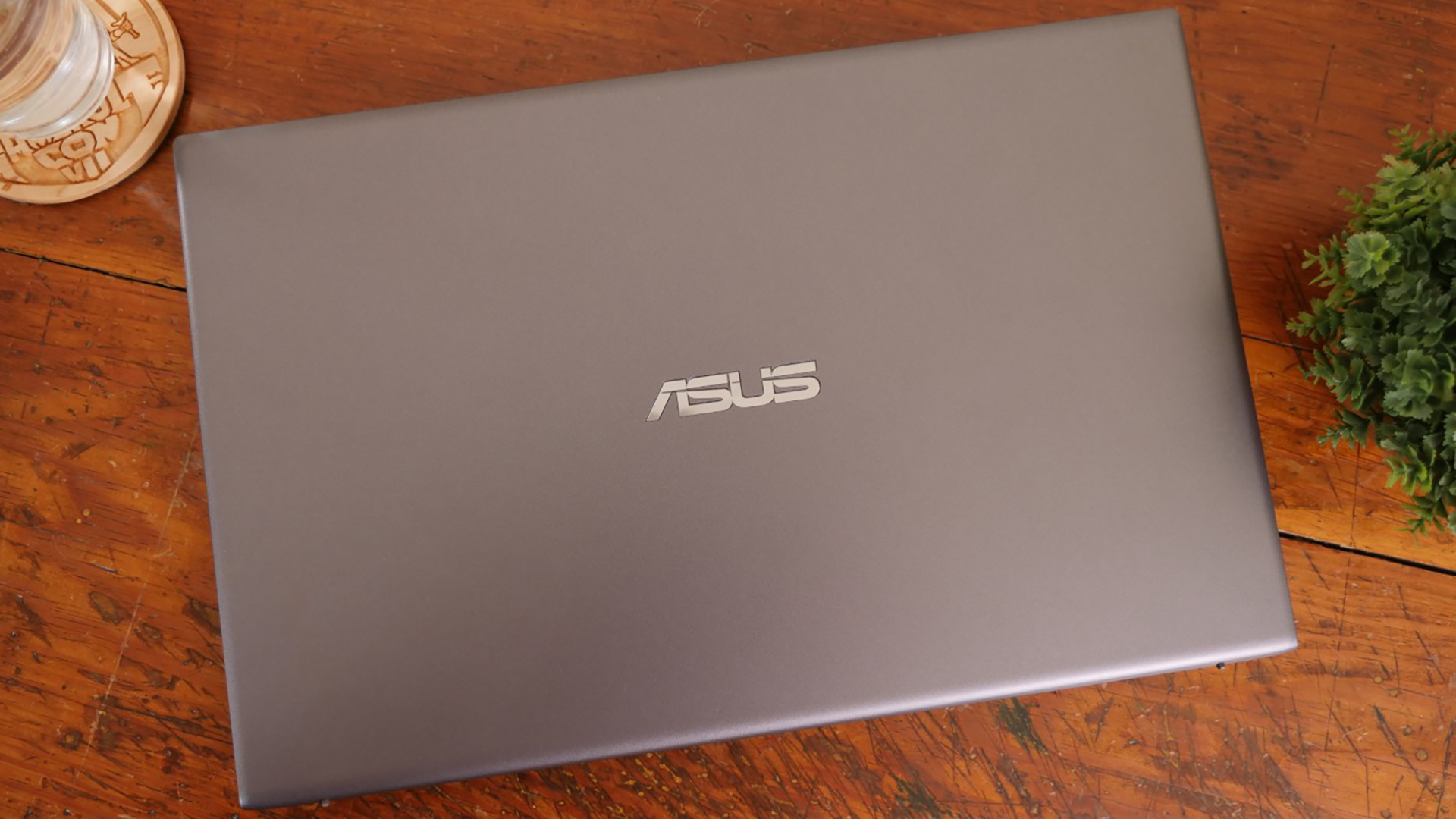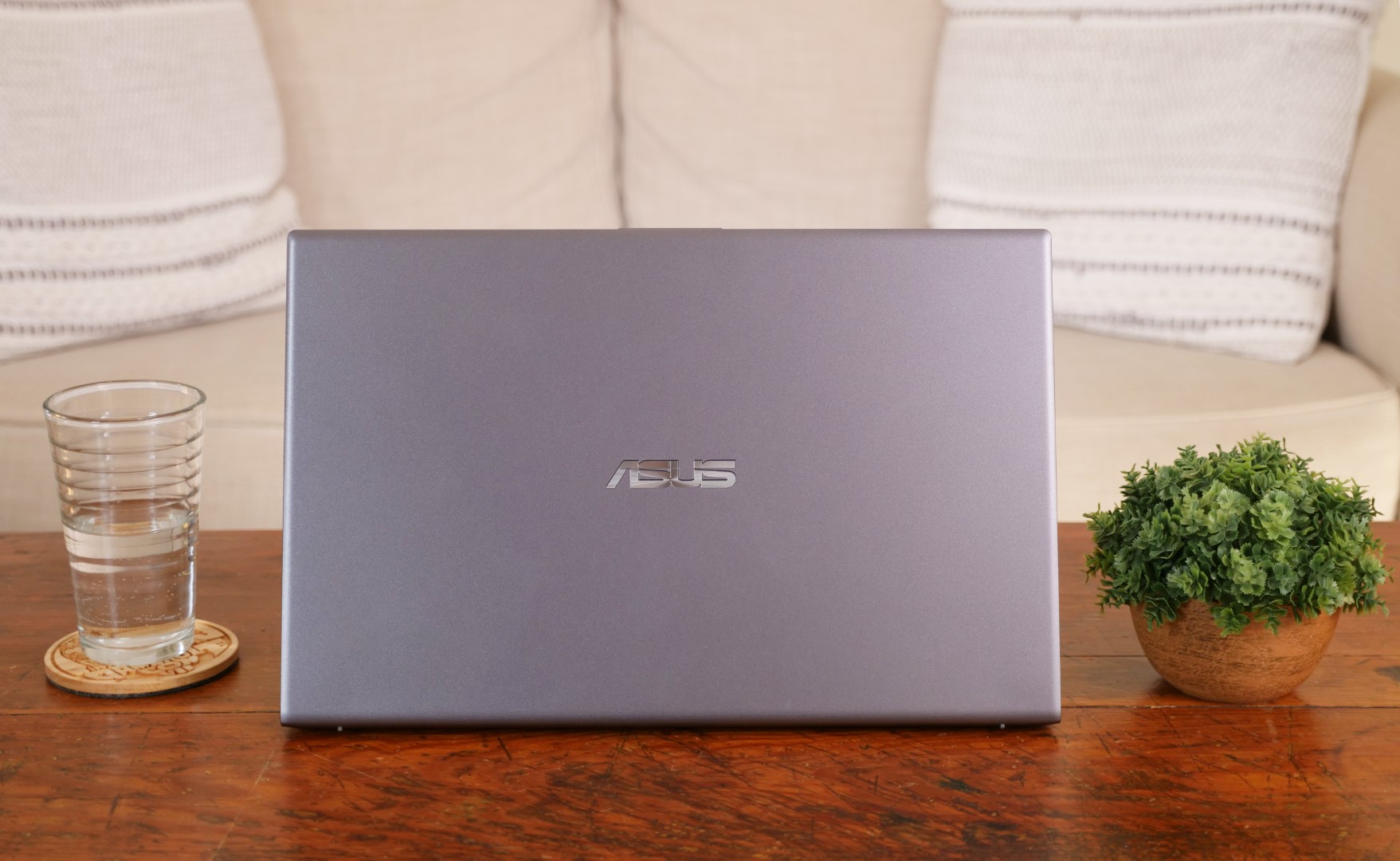Laptop Mag Verdict
The Asus VivoBook 15 (2020) may impress you with its premium look, but its meager battery life, weak audio and dim display will quickly change your mind.
Pros
- +
Premium design
- +
Minimal bezels
- +
Solid port selection
Cons
- -
Sub-par battery life
- -
Dim and dull display
- -
Below average CPU performance
- -
Weak audio
Why you can trust Laptop Mag
Price: $399
CPU: Intel Core i3-1005G1
GPU: Intel UHD
RAM: 8GB
Storage: 128GB SSD
Display: 15.6-inch, 1920 x 1080
Battery: 5:20
Size: 14.1 x 9.2 x 0.8 inches
Weight: 3.7 pounds
The Asus VivoBook 15 (2020) costs $399 and, like some other lower-priced options from Asus, manages to deliver a premium look befitting a notebook twice the price. Given the price, the overall size and weight of the VivoBook 15, a laptop with a 15.6-inch screen, is a pleasant surprise as well.
Unfortunately, things fall apart a bit from there; the display is dim and dull and the battery life is short even for a laptop in this price range. Performance holds up OK for simple web work, but anything more taxing is going to be painfully slow on its Intel Core i3-1005G1 processor.
There are some nice design touches on the Asus VivoBook 15 (2020) and, if you need a laptop at this price point, there are certainly worse options out there. However, you should consider taking a look at our best laptops under $500 or, if Windows 10 isn’t a necessity, our best Chromebooks rankings for other options.
Asus VivoBook 15 (2020) price and configuration options
My review model of the VivoBook 15 is priced at $399 and comes with an Intel Core i3-1005G1 processor, 8GB of RAM and a 128GB SSD and Intel UHD Graphics.
There is one other Intel variant of the VivoBook 15 F512 available, the F512JA-AS54, which steps you up to an Intel i5-1035G1 CPU and 512GB of storage for $599. Alternatively, there’s an AMD option, the VivoBook 15 F512DA, which includes a Ryzen 7 3700U processor and 512GB of storage for $649.
Asus VivoBook 15 (2020) design

Asus has done a solid job of carrying over some of the premium design touches of its higher-end ZenBook line. While picking up the VivoBook 15 (2020) gives away the plastic construction both due to feel and the plain black plastic bottom, the illusion is intact when it is sitting on a desk. The textured Slate Grey finish paired with the silver metallic sheen of the Asus logo centered on the lid makes for a nice contrast.
Lifting the Slate Grey lid reveals the ErgoLift Hinge, which angles the keyboard deck slightly upward for a superior typing experience. The interior of the laptop carries over the same finish as the lid, including a color-matched trackpad with a built-in fingerprint sensor while the keyboard breaks from this with a standard black finish. The area around the keyboard also gets a subtle texture change with tiny indentations and it is slightly recessed, presumably to avoid contact with the display when closed. The NanoEdge Display lives up to its name with minimal bezels on each side, but it would be nice if that included the top bezel as well.
Sign up to receive The Snapshot, a free special dispatch from Laptop Mag, in your inbox.
At 3.7 pounds, 14.1 x 9.2 x 0.8-inches, the VivoBook 15 isn’t going to be challenging premium thin and light laptops, but it compares favorably to other 15-inch laptops in this price range. It comes in just a hair lighter than our top choice for best laptops under $500, the Acer Aspire 5 (3.8 pounds, 14.3 x 9.9 x 0.7-inches), and it's even lighter than the HP 15 Laptop (4.4 pounds, 14.8 x 9.7 x 0.9-inches). Thanks to its thinner and narrower dimensions, it will fit in a slightly more compact laptop bag as well.
Asus VivoBook 15 (2020) ports

If you haven’t converted to an all USB Type-C life, then the bounty of ports on the VivoBook 15 is going to be a welcome sight as this laptop offers a solid array of options.
The left side of the laptop is somewhat sparse with just two traditional USB Type-A ports, both USB 2.0, but things get a lot more interesting on the other side.
The right side of the Asus VivoBook 15 (2020) features a power jack, another USB Type-A port (USB 3.1), an HDMI 2.0 port, a USB Type-C port, a combo headphone/mic jack and finally a microSD card slot.
While I would swap out one of the USB Type-A ports for a second USB Type-C port, overall this is an excellent setup. If you do happen to need an additional port, an RJ45 Ethernet port or a full-size SD card reader, for example, you can take a look at our best USB Type-C hubs page and take advantage of that powerful port.

Asus VivoBook 15 (2020) display
The VivoBook 15's 15.6-inch, 1920 x 1080 display produces sharp images, but I found the colors were washed out and the panel overall was quite dim.
Watching the trailer for the live-action remake of Mulan, the VivoBook 15 couldn’t reproduce the vivid red of the titular character’s costume and left the rich and varied environments feeling drab and listless. The screen also suffers from a somewhat aggressive sweet spot when it comes to your viewing position; if you get just a bit off-center in any direction, the image falls off quickly.

Our colorimeter backed up my experiences with the VivoBook 15's display, which displays only 65% of the sRGB color gamut. This actually comes in slightly ahead of the Acer Aspire 5 (63%) and just behind the HP 15 Laptop (67%), but is well behind the category average of 85%.
Brightness is a serious weakness of the Asus VivoBook 15, which is capable of only 205 nits in our testing. That compares poorly to the Acer Aspire 5 (258 nits) and even the HP 15 Laptop (222 nits), which were also below the category average of 268 nits.
Asus VivoBook 15 (2020) keyboard and touchpad

I averaged 80 words per minute on the 10fastfingers.com typing test with the VivoBook 15, which is slower than my current average of 86 wpm. I was surprised that the 1.4 millimeter key travel wasn’t more comfortable. Instead I found the keys were mushy and lacked a strong bounce that helps move your fingers from key to key.
The key spacing is excellent for the most part, I just wish there was a slightly greater separation between the standard keyboard and the numpad, but its presence is great for those who need to enter figures regularly. I was pleasantly surprised by the backlighting on the keyboard, it delivered even lighting on the keys and made for an easy low-light typing experience.
Turning to the touchpad, the 4.1 x 2.9-inch surface is large enough for basic navigation and Windows 10 gestures. The panel was to be responsive and accurate. I did, however, run into a couple of things that I didn’t like about the touchpad. Clicking doesn’t feel great on either side and causes a flex across the exterior of the touchpad. Also, the inclusion of the fingerprint sensor on the touchpad is awkward despite its convenience when quickly logging in.

Asus VivoBook 15 (2020) audio
The dual bottom-firing speakers on the VivoBook 15 manage to stay clear throughout their range, but simply aren’t capable of high volume and can’t produce any meaningful bass.
I listened to “Snowchild” by The Weeknd and even at full volume, the VivoBook 15 couldn’t fill my small living room to a satisfying degree. The vocals were acceptable, but lack some of the punch that you would get with a more premium set of speakers or good headphones. The atmospheric music simply doesn’t come through even when I sat directly in front of the laptop.
Asus VivoBook 15 (2020) performance
The Intel Core i3-1005G1 processor paired with 8GB of RAM doesn’t sound impressive, but the laptop loaded up two dozen Google Chrome tabs, including two YouTube videos running at 1080p and a pair of Twitch streams without a stutter as I jumped between all of them. Obviously, you aren’t picking up the VivoBook 15 for gaming, but when it comes to simultaneously handling an array of web tasks and apps, you shouldn’t have any issues.
However, performance benchmarks were less than glowing for the Asus VivoBook 15. The notebook got a score of 2,399 on the Geekbench 5 test overall performance, well below the 2,744 of the Acer Aspire 5 and even further behind the category average of 2,983.

Our Handbrake video transcoding test, which requires the laptop to convert a 4K video to 1080p resolution, was similarly difficult for the VivoBook 15. The laptop finished with a time of 28 minutes and 33 seconds. This was quite a bit longer than the Acer Aspire 5’s 21:55-finish and the 25:53 time of the HP 15 Laptop. With that said, it handily beats the budget laptop category average of 39 minutes and 20 seconds, so if you need to do some video conversion in a pinch, things could be much worse.
The VivoBook 15’s 128GB SSD isn’t doing it any favors taking 29 seconds to duplicate 4.97GB of mixed-media. This is good for a transfer rate of 177 megabytes per second. And while it was well ahead of the HP 15 Laptop (57 Mbps), it was considerably slower than the Acer Aspire 5 (369.4 Mbps) and nearly a third the speed of the category average (452 Mbps).
Asus VivoBook 15 (2020) graphics
With the Intel UHD graphics of the VivoBook 15 aren’t going to have you playing any remotely demanding games, but that isn’t really expected. If you are set on a gaming PC, you’ll need to spend up at least a bit more on one of our best cheap gaming laptops.
The VivoBook 15 managed only 8 frames per second on Sid Meier’s Civilization VI: Gathering Storm, well shy of our 30-fps playability threshold.
Asus VivoBook 15 (2020) battery life
Depending on your use case, the battery life result for the VivoBook 15 might be the nail in its coffin as it lasted only 5 hours and 20 minutes during our test, which involves continuous Web surfing over Wi-Fi at 150 nits of brightness. This was good enough to beat the HP 15 Laptop (4:57), but it's well below the 6:55 of the Acer Aspire 5 and the average across all budget laptops (6:39).
Asus VivoBook 15 (2020) camera

It’s hardly alone in this problem, but the Asus VivoBook 15 is an excellent reminder to pick up an external webcam, particularly considering the frequent use of video conferencing and video chat apps these days.
A glimpse at the live image on the display might fool you depending on the lighting, but take a selfie with the 720p camera even in bright light and you’ll immediately see an abundance of noise and a complete lack of detail.
Asus VivoBook 15 (2020) heat
The exhaust vent that runs the length of the VivoBook 15’s back edge coupled with the trio of vents on the bottom of the laptop were enough to help it breeze through our heat test without a problem.
The test involves playing a 15-minute, 1080p video and then taking temperature readings on various parts of the laptop. On the VivoBook 15, the touchpad remained at a cool 72 degrees Fahrenheit while the underside got a little toastier at 91 degrees, but even its hottest spot, next to the rear vent, never went above our 95-degree comfort threshold.
Asus VivoBook 15 (2020) software and warranty
Asus doesn’t overload you with proprietary software or even much bloatware. There is no Candy Crush in sight, for example, but it does offer you an AudioWizard app to try to squeeze more performance out of the speakers and the useful MyAsus app that provides you with information regarding your warranty and service options along with the serial number and access to some system utilities.
You can use the MyAsus app to tweak your hardware settings for the display, battery, and other such features. It also includes a tab that will offer deals on some apps, like the Adobe Suite. It will also walk you through the process of installing and connecting the link to MyAsus app for your smartphone, which allows you to control your iOS or Android smartphone to varying degrees.
The VivoBook 15 ships in Windows 10 S Mode, but switching to full Windows 10 is free and easy if you want to be able to install non-Windows store apps. Just be aware that once you switch over, there is no going back to S Mode.
The VivoBook 15 comes with a one-year limited warranty. You can see how Asus fares in general on this front in our Tech Support Showdown and Best and Worst Brands special reports.

Bottom line
The Asus VivoBook 15 is an excellent looking laptop for $399, but the performance and overall feature set just doesn’t deliver on the promise of its design. The display looks great in terms of a minimal bezel experience, but that only lasts until you power it on because the screen is dim and dull.
There are aspects of the keyboard experience that are good, the ErgoLift hinge does a nice job of angling the keyboard slightly and the spacing and key travel are quite nice, but it’s undercut by the sponginess of the keys.
And while the size and weight of the VivoBook 15 would make it a relatively nice option for those that need to haul their laptop around, the pretty abysmal battery life makes it tough to recommend for that purpose. While there are always going to be trade-offs on a sub-$400 laptop, there should still be some highlights, and there just aren’t enough of them to recommend the VivoBook 15.
Asus VivoBook 15 (2020) Specs
| ReleaseDate | 15/09/2020 |
Sean Riley has been covering tech professionally for over a decade now. Most of that time was as a freelancer covering varied topics including phones, wearables, tablets, smart home devices, laptops, AR, VR, mobile payments, fintech, and more. Sean is the resident mobile expert at Laptop Mag, specializing in phones and wearables, you'll find plenty of news, reviews, how-to, and opinion pieces on these subjects from him here. But Laptop Mag has also proven a perfect fit for that broad range of interests with reviews and news on the latest laptops, VR games, and computer accessories along with coverage on everything from NFTs to cybersecurity and more.


